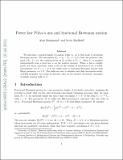| dc.contributor.author | Hammond, Alan | |
| dc.contributor.author | Sheffield, Scott Roger | |
| dc.date.accessioned | 2015-01-23T18:30:33Z | |
| dc.date.available | 2015-01-23T18:30:33Z | |
| dc.date.issued | 2012-12 | |
| dc.date.submitted | 2010-04 | |
| dc.identifier.issn | 0178-8051 | |
| dc.identifier.issn | 1432-2064 | |
| dc.identifier.uri | http://hdl.handle.net/1721.1/93178 | |
| dc.description.abstract | We introduce a natural family of random walks S[subscript n] on Z that scale to fractional Brownian motion. The increments X[subscript n] := S[subscript n] − S[subscript n]−1 ∈ {±1} have the property that given {X[subscript k] : k < n}, the conditional law of X[subscript n] is that of X[subscript n−k[subscript n]] , where k[subscript n] is sampled independently from a fixed law μ on the positive integers. When μ has a roughly power law decay (precisely, when μ lies in the domain of attraction of an α-stable subordinator, for 0 < α < 1/2) the walks scale to fractional Brownian motion with Hurst parameter α + 1/2. The walks are easy to simulate and their increments satisfy an FKG inequality. In a sense we describe, they are the natural “fractional” analogues of simple random walk on Z. | en_US |
| dc.description.sponsorship | National Science Foundation (U.S.) (Grant DMS-0403182) | en_US |
| dc.description.sponsorship | National Science Foundation (U.S.) (Grant DMS-0645585) | en_US |
| dc.description.sponsorship | National Science Foundation (U.S.) (Grant OISE-07-30136) | en_US |
| dc.language.iso | en_US | |
| dc.publisher | Springer-Verlag | en_US |
| dc.relation.isversionof | http://dx.doi.org/10.1007/s00440-012-0468-6 | en_US |
| dc.rights | Creative Commons Attribution-Noncommercial-Share Alike | en_US |
| dc.rights.uri | http://creativecommons.org/licenses/by-nc-sa/4.0/ | en_US |
| dc.source | arXiv | en_US |
| dc.title | Power law Polya’s urn and fractional Brownian motion | en_US |
| dc.type | Article | en_US |
| dc.identifier.citation | Hammond, Alan, and Scott Sheffield. “Power Law Polya’s Urn and Fractional Brownian Motion.” Probability Theory and Related Fields 157, no. 3–4 (December 11, 2012): 691–719. | en_US |
| dc.contributor.department | Massachusetts Institute of Technology. Department of Mathematics | en_US |
| dc.contributor.mitauthor | Sheffield, Scott Roger | en_US |
| dc.relation.journal | Probability Theory and Related Fields | en_US |
| dc.eprint.version | Original manuscript | en_US |
| dc.type.uri | http://purl.org/eprint/type/JournalArticle | en_US |
| eprint.status | http://purl.org/eprint/status/NonPeerReviewed | en_US |
| dspace.orderedauthors | Hammond, Alan; Sheffield, Scott | en_US |
| dc.identifier.orcid | https://orcid.org/0000-0002-5951-4933 | |
| mit.license | OPEN_ACCESS_POLICY | en_US |
| mit.metadata.status | Complete | |
